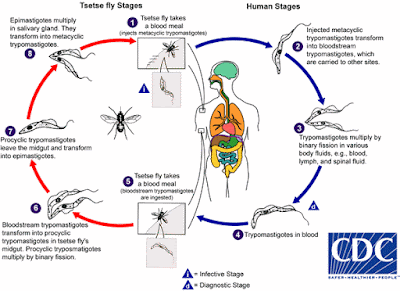To Control Trypanosomiasis or To Preserve Wildlife Habitat?
The Tsetse fly is commonly known as the vector that carries the “sleeping sickness” of humans and animals. Because of the geographical niche of these flies, as well as the reproductive traits, the endemic of Trypanosoma is high in about 36 countries in the sub-Saharan African population, often known as the “fly belt.” Due to the Trypanosoma endemic, Tsetse flies have had a significant influence on the food production, natural resources, and human population in particular to this region.
The Tsetse fly is apart of the group Insecta, the order Diptera, the family Glossinidae, and the genus Glossina. There are approximately 30 named species and subspecies to date. Out of the 30 species of Tsetse flies, only 6 transmit Trypanosomiases sleeping sickness. Amongst these 6, T. congolese and T. vivax, often known as Nagana are especially detrimental due to their full range of animal reservoirs. The Tsetse fly, in regards to no particular species, can be easily distinguished between other flies due to its rigid proboscis and wing venation.
The Tsetse fly feeds on blood, which is how Trypanosomiasis is transmitted to animals and humans. The Tsetse fly takes a blood meal and ingests the trypomastigote form of Trypanosoma. Once ingested, the trypomastigote stage goes through a series of cycles as well as binary fission to become the metacyclic trypomastigote stage that resides in the salivary gland of the Tsetse fly. The metacyclic trypomastigote thus becomes infective to humans and animals. With time, the typical symptoms of Trypanosomiasis such as fatigue, headaches, fever, and muscle aches turn into nervous system malfunctions, which is why it is referred to as the “sleeping” sickness.
More
than 30 species of wild animals can be infected by Trypanosomes such as cattle,
pigs, leopards, lions, etc. Because of this large number, some researchers say
that it is nearly impossible to practice large-scale farming in Tetste infested
areas, and approximately 10 million square kilometers of land cannot be farmed.
In 1974, the World Food Conference created the FAO program for the control of
African Animal Trypanosomiasis due to extreme losses in cattle alone, and
millions of dollars wasted. To control the endemic, FAO has tried to regulate
the amount of interaction between humans and animals (especially cattle), the
intensity of cultivation, and the growth of livestock.
There are various control methods in place to reduce the amount of African Animal Trypanosomiasis by the Tsetse fly to maintain the agricultural systems in regards to cattle. Such measures include insecticides, the release of sterile males into the environment, removal of vegetation, reducing the number of flies, or killing the infected animal reservoirs. However, by reducing the number of flies and vegetation, and to create sterile males, reduces both the natural habitat and life cycle of the Tsetse fly itself, which poses a problem. This poses a question, how to sustain the wildlife population of the Tsetse fly while trying to get rid of the endemic of the African Trypanosomiasis infection in humans and animals.
Reference List
Macdonald, Jessica. “The Tsetse Fly and African Sleeping Sickness.” TripSavvy, Tripsavvy, 10 July 2017, www.tripsavvy.com/avoiding-the-tsetse-fly-on-safari-1454081.
Service, M. W. “Tsetse Flies (Order Diptera: Family Glossinidae).” SpringerLink, Springer, Dordrecht, 1 Jan. 1980, link.springer.com/chapter/10.1007/978-1-349-16334-2_11.
“The Tsetse Fly and Its Effects on Agriculture in Sub-Saharan Africa.” Fao.org, FAO of the UN, www.fao.org/ag/Aga/agap/FRG/FEEDback/War/V8180b/v8180b0s.htm.





This is very interesting. thanks for that. we need more sites like this. i commend you on your great content and excellent topic choices. al hirschfeld free health clinic new york ny Useful information shared..I am very happy to read this article..thanks for giving us nice info.Fantastic walk-through. I appreciate this post.
ReplyDelete